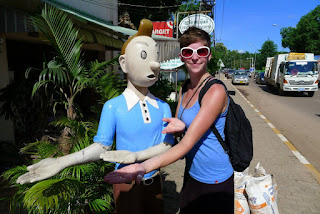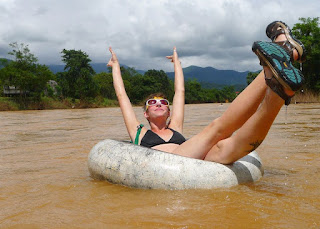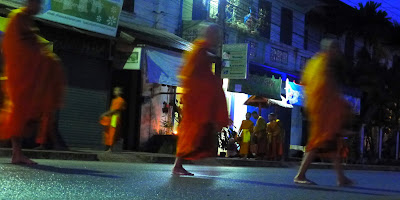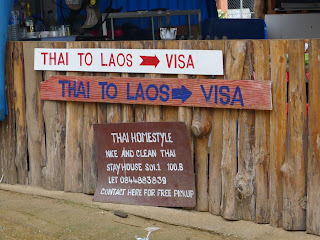 |
| Fellow adventurer. |
We had hoped to make more of an adventure of it--some companies in Vang Vieng offer a kayaking trip to Vientiane--but unfortunately the river was running too strong and the trip was cancelled. So we hopped another minivan for the 4 hour journey. When we arrive it takes a little while to secure a reasonable guesthouse. The cheap ones downtown seem to be sold-out, and the slightly more expensive ones don't seem to be worth it. We get tired of lugging our bags around and settle on one that's about 90,000 kip (about $11.25) which is way more than we'd usually spend. But we shrug it off, drop our stuff and head off on foot for the Vietnamese embassy.
Vientiane sits on the Mekong River, about 18km from the First Friendship Bridge that established an easy place to cross into Thailand. As the biggest city in Laos, it's also the economic center of the country. But it doesn't show it's size: the traffic is mild by SE Asian standards and the air is breathable.
 |
Typically, we find ourselves hiking the city streets in the midday sun, but we catch our first glimpse of the Arc de Triomphe-style Patuxai (Victory Gate) and arrive at the embassy thankful for their blasting AC and free water. After a little paperwork we fork over $40 a piece (they only accept US cash) and are told to return in 2 days to pick up our visas.
 |
| Patuxai (Victory Gate) |
Back out in the heat we slowly make our way back to the guesthouse, strolling through the park surrounding the Victory Gate and just generally soaking up the city's atmosphere. Another sign of the French colonial influence--all the street signs are posted in Lao and French. It's actually kind of refreshing after 6 weeks and nothing but indecipherable characters.
That evening we hit up a rooftop bar along the river for one of the most beautiful sunsets of the trip so far. I nearly drop my iPhone four stories down off the ledge while snapping a picture, but Sadrah miraculously saves it. After that scare we stroll the market below in the waning twilight, find a place for dinner and head back to the guesthouse for the night.
We spend the next morning trekking out to the COPE Visitors Center. COPE is a non-profit organization that works to provide access to prosthesis, wheelchairs and physical/occupational therapy for those who cannot afford it. While the scope of their work is not limited to people who are injured by UXO's (unexploded ordinance) it is a clearly a big part of what they do.
Before entering the museum we're greeted by a wonderful young man who calls himself Small Kim. He is receiving care at the center and has been given the job of greeting guests to the museum. He's blind and has lost both his hands, but the strength of his spirit is immeasurable. We talk with him for a good 10 minutes, in awe of his eager questions. How do we like Laos? Have we been to California? How many people live in California? He has a friend in Colorado. How big is Colorado? Do we know Michael Jackson? He tells us all about the English parents who have (we think) adopted him--he named himself after his adoptive mother, who he calls Big Kim. His smile and energy are just amazing.
Inside we have our first real look at the horrors our government wrought on the Lao people during the Vietnam War. The US dropped what are called cluster bombs: massive 600lb. bombs filled with little "bombies" all over the Lao countryside. In mid-air the cluster bomb opens and the bombies are dispersed. Each bombie, about the size of a tennis ball, is designed to explode on impact sending shrapnel (often tiny ball bearings) in every direction. Unfortunately, many didn't explode on impact. They estimate that of the 260 million bombies dropped in Lao PDR during the war, 80 million did not explode. These UXO's are still injuring around 300 people a year in Laos--farmers can't clear their land, roads can't be built, children can't play in their yards. It's devastating and sad, and as Americans we can't help but feel a little guilty.
Before entering the museum we're greeted by a wonderful young man who calls himself Small Kim. He is receiving care at the center and has been given the job of greeting guests to the museum. He's blind and has lost both his hands, but the strength of his spirit is immeasurable. We talk with him for a good 10 minutes, in awe of his eager questions. How do we like Laos? Have we been to California? How many people live in California? He has a friend in Colorado. How big is Colorado? Do we know Michael Jackson? He tells us all about the English parents who have (we think) adopted him--he named himself after his adoptive mother, who he calls Big Kim. His smile and energy are just amazing.
 |
| COPE Center |
 |
| Bombie art. |
No one should use these things again, ever. Go here to learn more about the campaign to ban the use of cluster bombs.
After the museum we're content to skip out on any more sight-seeing, so we while away the afternoon at a community pool. Lots of chlorine, lots of kids, lots of sun. So we catch up on our books, soak up some rays, take a dip and repeat.
 |
| Swimmin' hole. |
The rest of our stay in Vientiane is marked by postcard mailing and unmistakable smells of freshly-baked bread. I couldn't resist, and clearly I'm quite happy about it. There is not alot of good bread in Thailand.
We've also become completely sick and tired of the gigantic Lonely Planet's Southeast Asia on a Shoestring that we have the wrestle out of my bag every time we need to check an address or scan a map. So, we pick up a bootleg copy of a Lonely Planet's (would've bought another brand if we could've found one) Vietnam travel guide for a whole $5. This should do for the next leg of the trip--it's probably a little older than the most recent version, but for 1/5 of the original price it'll do the trick.
Our visas are ready to go by mid-afternoon on our 3rd day in Vientiane, so we decide to save some time and grab an overnight bus to our next destination. I know I'm never going to get a true night's sleep on an overnight bus (unless it's a sleeper) but sometimes it's a good idea when it saves valuable time and the cost of an extra night's stay in a guesthouse.
We certainly did not get the sleeper bus--not that there was one available to get. We also did not get the AC bus we were promised. But in exchange, we did get the 2AM "dinner" stop bus. Nothing beats a bowl of mystery stew and an energy drink at 2AM right? Well, nothing except a 3:30AM bathroom stop in the middle of nowhere. Men and women alike empty off of the bus in complete darkness, wander 10 or 15 meters in all directions and take care of their business. Arrive groggy, we will...











































